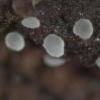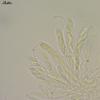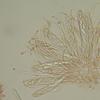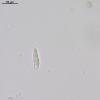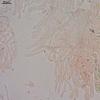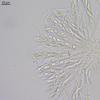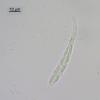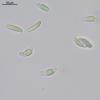
06-12-2025 00:19
 Viktorie Halasu
Viktorie Halasu
Hello, would anyone have this article, please? An

05-12-2025 17:33
 Bruno Coué
Bruno Coué
Bonjour, je serais heureux de recueillir votre avi

02-12-2025 18:59
This pair of ascos 2.5cm across were on recently b

02-12-2025 19:25
Buckwheat PeteHello, can anyone identify this hairy fungus growi

30-11-2025 12:53
 Edvin Johannesen
Edvin Johannesen
White short-stipitate apothecia found on thin twig

30-11-2025 10:47
 William Slosse
William Slosse
I recently found a collection of small Peziza sp.
Polydesmia sp.
Nina Filippova,
24-01-2013 13:29
1) probably Polydesmia, but asci with inamyloid pore, and spores nonseptate, otherwise paraphyses propoloid, and if to follow the key of Korf (1978) it may be P. fructicola.
Apothecia pustulate to flat-cupulate, grayish, translucent, up to 400 x 100 mk, hymenium minutely rough, outside and edge appear smooth.
Excipulum textura prismatica, outer hyphae end by ventricose or clavate cells (hairs); asci clavate, clamped, with inamyloid pore, 54 x 7 mk; spores ellipsoid and curved (allantoid), non-septate, with large irregular guttulae, 11,6 (10-13,1) x 3,4 (3,1-3,9) mk; paraphyses irregularly bulged in different parts, branched 2-3 times, curved at the tips.
Hans-Otto Baral,
24-01-2013 15:08

Re : Polydesmia sp.
Dear Nina
Polydesmia has 3-septate spores and amyloid asci, and these apically curved paraphyses are also untypical of that genus.
Do you have the fungus fresh? Please do photos in water, that would greatly help. Possibly there are guttules in the paraphyses that disappear when mounting in such lethal agent.
Zotto
Polydesmia has 3-septate spores and amyloid asci, and these apically curved paraphyses are also untypical of that genus.
Do you have the fungus fresh? Please do photos in water, that would greatly help. Possibly there are guttules in the paraphyses that disappear when mounting in such lethal agent.
Zotto
Nina Filippova,
24-01-2013 21:16
Hans-Otto Baral,
24-01-2013 22:30

Re : Polydesmia sp.
Good photos, but regrettably all in dead state. I assume the fungus was collected some weeks ago and was dried? Then these guttules disappear irreversibly.
I am sorry I have no idea of a genus. My idea was something around Naeviopsis, but I do not believe.
Zotto
I am sorry I have no idea of a genus. My idea was something around Naeviopsis, but I do not believe.
Zotto
